

Squattercity. Mini documentaries on the informal city. The slum solution to housing crisis. Favela Skyscraper in Rocinha, Brazil. Rocinha, Brazil, is one of the world’s largest slums with a population over 150,000 people.

It is located in the southern part of Rio de Janeiro; a hillside the overlooks the city and the ocean. In the 1930’s the Rocinha community emerged from the division of large farm fields and in the 1940’s and 1950’s it was the epicenter of illegal settlements with lack of regulation. The result is an area with a strong community bonds but without any infrastructure or security. Déficit habitacional de São Paulo chega a 1,5 milhões « Outra Política.
Favela Heliópolis - São Paulo.

Cidadeinformal » Photos. Favelas Building, Brazil, Belo Horizonte Building, Architect, Favelas Belo Horizonte. Favelas Building, Brazil Building, Architect, Project, News, Design, Property, Image Brazilian Favelas Building – Belo Horizonte : Architecture Information 11 Mar 2010.
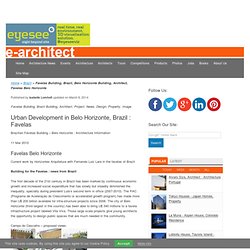
Improving Quality of Life in Sprawling Slums. Ed note: We want to welcome our newest contributor to these pages.
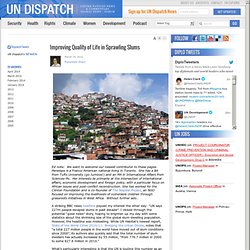
Penelope is a Franco-American national living in Toronto. She has a BA from Tufts University (go Jumbos!) And an MA in International Affairs from Sciences-Po. Her interests lie primarily at the intersection of international affairs, economic development and foreign policy, with a particular focus on African issues and post-conflict reconstruction.
Design with the Other 90% {{..networkedcultures..} Helmut Batista. Helmut Batista was born in 1964 in Rio de Janeiro, Brazil.

He is the director of the non-profit contemporary art space CAPACETE at the Escola de Cinema e Audiovisual Darcy Ribeiro in downtown Rio de Janeiro. Between 1985 and 1997 he worked as an artist, set designer and camera assistant in Paris, Vienna and Milan. Regeneration of the Favela de Rocinha Slum / Jan Kudlicka. The research presented here was conducted by Jan Kudlicka, who spent the last year studying slum dwellings, known as “favelas,” in Brazil.
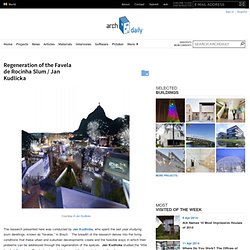
The breadth of the research delves into the living conditions that these urban and suburban developments create and the feasible ways in which their problems can be addressed through the regeneration of the spaces. Dharavi: globalization and spontaneously mixed uses. [The following piece, on the surprising ways that the residents of the Mumbai settlement of Dharavi have integrated that urban agglomeration into global economic networks, and the value of the unique spatial formatting that both enables and results from that integration, is the second thoroughly-footnoted guest post we've run from Peter Nunns.
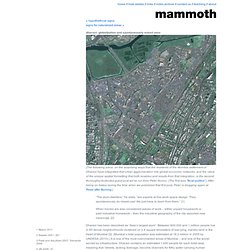
(The first was "fecal politics".) After being on hiatus during the time when we published that first post, Peter is blogging again at Read after Burning.] “The slum-dwellers,” he adds, “are experts at live-work space design. Africa's greatest hotel now Mozambique squat. Subtopia: Squatter Imaginaries. Santiago de Chile « We could wait no longer on shanty towns. Alice Springs' camps of despair are crying out for Government action.
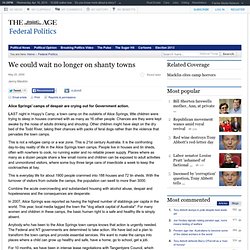
LAST night in Hoppy's Camp, a town camp on the outskirts of Alice Springs, little children were trying to sleep in houses crammed with as many as 16 other people. Chances are they were kept awake by the noise of adults drinking and shouting. Other children might have slept on the dry bed of the Todd River, taking their chances with packs of feral dogs rather than the violence that pervades the town camps. This is not a refugee camp or a war zone. This is 21st century Australia. Cañada Real (Madrid) La Cañada Real es como se conoce a la sucesión de asentamientos ilegales que se produce en un tramo de la Cañada Real Galiana a su paso por Madrid.
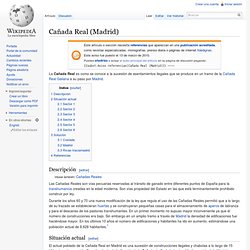
Las Cañadas Reales son vías pecuarias reservadas al tránsito de ganado entre diferentes puntos de España para la transhumancia creadas en la edad moderna. Son vías propiedad del Estado en las que está terminantemente prohibido construir por ley. Durante los años 60 y 70 una nueva modificación de la ley que regula el uso de las Cañadas Reales permitió que a lo largo de su trazado se establecieran huertas y se construyeran pequeñas casas para el almacenamiento de aperos de labranza y para el descanso de los pastores transhumantes.
En un primer momento no supuso mayor inconveniente ya que el número de construcciones era bajo. Sin embargo en un amplio tramo a través de Madrid la densidad de edificaciones fue haciéndose mayor. Discurre íntegramente por el término municipal de Madrid entre la autopista M-45 y la M-203 (carretera de Mejorada). Repositioning Practice: Teddy Cruz. Youths upgrade Kibera slum infrastructure as part of UN-HABITAT initiative. UN-HABITAT has announced a fresh resolve to tackle deteriorating living conditions in cities by harnessing the energy of the youth, Abubakar Ibrahim reported in a March 31 article on AllAfrica.com.
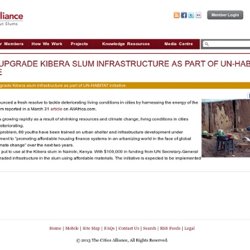
With urban populations growing rapidly as a result of shrinking resources and climate change, living conditions in cities around the world are deteriorating. 2007 Student Awards. This project offers a contemporary approach to upgrading informal settlements based on low impact landscape infrastructural solutions. Architecture, urban planning, and engineering are the traditional professions that have addressed issues of informal urbanization. However, this project demonstrates the role that landscape architecture can play in not only addressing public health and environmental issues but also in functioning as a catalyst for macro and micro enterprises. Definition:Informal settlements are lands that are settled by people or organizations that do not have legal claim or title to the land and are developed without permission from any government agency.
Informal settlements often lack basic infrastructure and urban services like roads, drainage and waste collection. The Social Urbanizer: Porto Alegre's Land Policy Experiment. Landscape Architecture Group - Wageningen UR - Wageningen University. Urban landscapes - neal oshima. Manila 01 - Start of morning commute, Magallanes Interchange, Makati City. Manila 02 - Bankal settlement, since demolished, Makati City. Manila 03 - Philippine National Railroad Compound, Metro Manila. Global Studio. 361 Degree 2010.
Jaigaon. Vila Cruzeiro. Oficina Informal. Líderes: Antonio Yemail y Juan Carlos YepesMiembros: asociación abierta y orgánica Bogotá, 2007 Interconexiones entre miembros. Rec-comunidad-audiovisual-lr.jpg (JPEG Image, 1100×399 pixels) Alejandro Aravena. ELEMENTAL is a for profit company with social interest, whose shareholders are the Universidad Católica de Chile, COPEC (Chilean Oil Company) and the Elemental founders. Its field of action is the city: the development of housing, public space, infrastructure and transportation projects that can perform as an effective and efficient upgrade in the quality of life of the poor.
ELEMENTAL operates in contexts of scarce resources, using the city as a source of equality, and moreover, as a shortcut to correct inequalities. When Elemental began in Harvard University in 2000, social housing was associated with a lack of economic and professional resources that had generated a lack of options for poor families. Elemental wanted to change this negative association, using professional skills to work with social housing. SCALE. ELEMENTAL. Kim Dovey Informal Settlements.